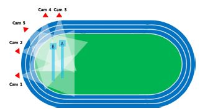
The purpose of the study was to investigate the relationship between the different kinematical variables with respect to the records and techniques performed by the participants during the 2011 Daegu IAAF World Championships Men's Pole Vault Event. Subjects chosen for the study were 8 male athletes who were selected for men's pole vault finals (highly skilled group) and 7 athletes who scored lowest record (skilled group) from the men's pole vault qualifying round. Personal best record of the each subjects were chosen to perform two dimensional (2D) and three dimensional (3D) video analyses. The data were obtained at 60 Hz with the use of five video cameras and digitizing was performed. Kinematical variables were calculated after smoothing the data using 2nd order Low-Pass Butterworth filter at cut-off frequency of 10 Hz and Independent samples t-test was performed to test any differences between two subject groups. The results: during the run-up stage, the horizontal velocity rate of the number of steps and run-up phase was obtained higher in highly skilled group than skilled group. During the take-off phase, deceleration in the horizontal velocity rate was observed in highly skilled group than skilled group. Distinct technical characteristics of distant and lower take-off of the take-off angle (angle of pole support) were also observed in highly skilled group than skilled group. During the pole bending and releasing phase, horizontal velocity was generally higher in highly skilled group than skilled group. It is considered that highly skilled group was able to jump higher as the vertical velocity during the pole bending as well as release phase was much higher in comparison to the skilled group.



The objective of this study was to investigate the effects of 12-weeks of vitamin D supplementation and circuit training on skeletal muscle mass in elderly women with type 2 diabetes mellitus and vitamin D deficiency. Forty eight elderly women with type-2 diabetes mellitus and vitamin D deficiency were randomly assigned to control(n=10), vitamin D supplement(n=11), exercise(n=12), and vitamin D supplement+exercise(n=15) groups. Dependent variables were measured before and after the 12-week interventions. Major outcomes included body composition, fasting glucose, insulin, and 25(OH)D concentration. ASM(apeendicular skeletal muscle mass), SMI(skeletal muscle mass), and HOMA-IR (homeostasis model for insulin resistance) were calculated. Women assigned to the vitamin D supplement consumed 1,200 IU of vitamin D orally per week for 12 weeks. Women assigned to the exercise intervention performed a circuit training at an intensity of 60%~80% of HRmax with a frequency of 3 days per week for 12 weeks. Compared to control group, all groups had significant loss of body weight and increases in serum 25(OH)D after the 12-week intervention. ASM and SMI increased significantly in only vitamin D+exercise group. Regardless of treatments, no significant group differences were found in changed scores of fasting glucose, insulin, and HOMA-IR. In conclusion, vitamin D + exercise would improve the loss of ASM and SMI compared with vitamin D or exercise alone.

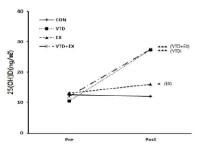
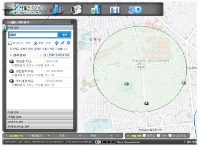
This study measured the accessibility of public exercise facilities within a residental area of a metropolitan community and examined how the accessibility can affect physical activity participation of residents. Initially, a total of 639 residents, who were aged between 19-70, visited Metabolic Syndrome Management Center of the Community Public Health Center, and registered for a Obesity Clinic Program, was listed as potential subjects. And those who responded to Physical Activity Questionnaire were selected for the analyses (n=92, 14.3% of 639). The relationships between physical activity level and accessibility to public exercise facilities were analyzed. Objective distance to public facility was related to ‘volume of participation to vigorous physical activity(r=.209)’, 'total volume of participation to physical activity(r=.206)’. And perceived distance to public facility was related to ‘volume of participation to vigorous-intensity physical activity(r=.235)’. perceived transport time to public facility was related to ‘duration of participation to vigorous-intensity physical activity(r=.239)’, ’volume of participation to vigorous-intensity physical activity(r=.306)’, and ‘volume of participation to total physical activity(r=.273)’. In contrast, the difference between objective distance to public facility and perceived subjective distance to the facility was negatively related to ‘duration of participation to moderate-intensity physical activity(r=-.221)’. The perceived numbers of public facility was positively related to ‘frequency of participation to vigorous-intensity physical activity(r=.237)’, ‘frequency of participation to walking(r=.273)’, ‘volume of participation to walking(r=.251)’ and 'total volume of participation to physical activity(r=.252)’. The predictor of 'total volume of participation to physical activity was perceived numbers of public facility(R2=.153, p=.046). The results revealed that the subjective accessibility to public health facilities was more influential to physical activity participation than the objective accessibility. Further research was warranted while using diverse populations as well as considering a inclusion of environmental factors.


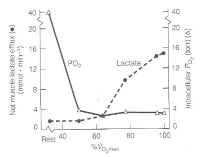
Lactate was considered a dead-end waste product of glycolysis due to lack of oxygen. Accumulating lactate in the muscle and blood was viewed only as a major cause of muscle fatigue and tissue damage. Furthermore, buildup of lactate due to glycogen re-synthesis is thought to cause excess oxygen consumption (oxygen debt) after exercise. However, research has also shown lactate to be an important mediator in numerous metabolic processes and a fuel for aerobic metabolism. Lactate is not metabolic waste, but a major player in cellular and whole body metabolism. Lactate can be used within the cell (intracellular lactate shuttle) or be transported through the cytoplasm or blood to be used by other cells (cell-cell lactate shuttle). Lactate shuttle hypothesis has helped in identifying and understanding the link between the glyoclyic and oxidative pathways, and identified lactate as a major energy source and gluconeogenic precursor. Therefore, the purpose of this review was to better understand the physiological roles of lactate at rest and during exercise, and the concept of lactate shuttle with implications for clinical practice.



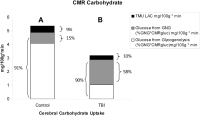
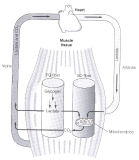
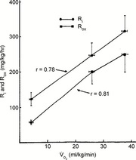
PURPOSE This study identified a company sports club’s dual characteristics— both for leisure activity and as an extension of work—to provide comprehensive interpretation and understanding of such clubs. METHODS A qualitative case study design was employed, incorporating in-depth interviews, nonparticipant observation, and supplementary data collection from 25 office workers who had participated in an in-house sports club for at least one year. RESULTS Participants reported a wide spectrum of motivations, from voluntary motives such as stress relief and health improvement to more obligatory or organizationally driven motives, including pressure from supervisors or colleagues and expectations related to performance evaluations. The club offered both team sports—which fostered teamwork and a sense of belonging—and individual sports—which offered personal development opportunities. However, some participants experienced blurring of work–leisure boundaries and reemergence of hierarchical organizational culture, leading to conflict and fatigue. CONCLUSIONS Overall, Although company sports clubs have become a welfare program that provides employees with opportunities for leisure and self-development and promote inter-departmental communication and collaboration, they also carry the latent risk of imposing additional burdens and pressures on employees. These findings underscore the need for refined operational strategies and institutional improvements to mitigate negative outcomes and maximize such programs’ original intent.
PURPOSE This study assessed elite Taekwondo athletes’ physical fitness and developed reference standards for both their basic and specialized physical fitness. METHODS Data for analysis were collected from 870 athletes: from national teams, 123 elite Taekwondo athletes from the Performance Analysis and Assessment System (PAAS) administrator website (1999–2020); from regional sports centers, 731 collegiate and general division elite Taekwondo athletes (2015–2019); and from Y University, 16 elite Taekwondo athletes. Through measurement items’ selection and categorization, 20 physical fitness items were selected for the reference standards’ development, including 9 for basic fitness and 11 for specialized fitness. Taekwondo weight classes were divided into two: light + middle (fin, fly, bantam, feather) and middle + heavy (light, welter, middle, heavy). RESULTS Descriptive statistics for basic and specialized physical fitness items were categorized by gender and athletes’ fitness level. The reference standards’ development was aligned with existing standards, integrating the Cajori physical fitness 5-levels. It also introduced minimum physical fitness reference standards and target achievement reference standards for evaluating elite Taekwondo athletes’ physical fitness. CONCLUSIONS The reference standards proposed here can serve as objective indicators in selection of national representative athletes and also provide foundational data to establish fitness goals and evaluate future elite athletes’ physical fitness.
PURPOSE The purpose of this study was to investigate the applicability of proprioceptive-dependent training as an effective physical training method by analyzing the effects of proprioceptive-dependent training on the accuracy of perceived and actual distance as well as the correlation between the changes in the two variables. METHODS Thirty-six male college students took part in the experiment. Participants were beginners with no previous experience in golf or less than five times of experience. They were randomly assigned to one of three groups; proprioceptive-dependent training, visual-dependent training, and control, maintaining the same sample size per group. The experiment was carried out in the order of pre-test, practice section, and post-test. In the pre-test, putting was tested to assess the accuracy of perceptual and actual distance in the 1-15m distance in a random order using a digital putting analyzer. In the practice section, proprioceptive-dependent and visual-dependent training groups practiced a total of 90 putting, six times per distance with the eyes closed or open. The post-test was the same as the pre-test. The accuracy of perceived and actual distance and the correlation between the changes in the two variables were analyzed using the calculated absolute errors. RESULTS The results of this study showed that there was no difference between groups in pre-test. In contrast, in post-test, the absolute error was significantly decreased in the order of proprioceptive-dependent training, visual-dependent training, and control group in the three distance conditions. Besides, for the proprioceptive-dependent training group and visual-dependent training group, there was a significant positive correlation between the changes in the accuracy of perceived and actual distance. CONCLUSIONS These results provide insight into the applicability of proprioceptive-dependent training for enhancing motor performance by showing the effects of proprioceptive-dependent training on perceived distance, actual distance, and the correlation between the two variables.

The purpose of this study was to determine how acute active pc-video game affects kinematic variables and muscle activities of adolescents. Fourteen middle school students(age: 15.9±0.7 yrs, height: 171.3±6.1cm, weight: 60.0±5.4 kg, right handed) who have no musculoskeletal disorder were recruited as the subject according to having experience in using the pc-video game for more than six months. Maximum angle, angular velocity, and muscle activity of the upper extremity were determined for each trial. For each dependent variable, a paired t-test was performed to test if significant difference existed between pre- and post a 60 minute active pc-video game(p<.05). This study found that one hour pc-video game hour may not affect on movement and ROM of the finger and the wrist, whereas it may have an effect on muscle activity of the upper extremity. It seems that repetitive movement pattern during an active pc-video game may hinder muscle activity of adolescents’ upper extremity. Part of the increase in musculoskeletal disorders is linked to the amount of time adolescents are allowed to play video games. This study found that an active pc-video game appears to have negative effects on the upper extremity muscles. Since wrist movements are continually repeated throughout the video game, carpal tunnel syndrome may possibly be caused by long-term exposure to video games.

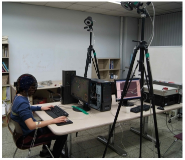
PURPOSE This study investigates the effectiveness of biomechanics information on intermediate golfers driver swing learning. It analyzes changes in center of pressure (COP) patterns, GRF Direction Inclination, driver performance, and learners psychological responses to determine the learning effects. METHODS Subjects were 32 right-handed male golfers (handicap 15-23) who had no difficulty in performing the golf driver swing (Full swing). Four groups were selected, BF (Biomechanics Feedback group), BVC (Biomechanics Verbal Cue group), CB (Combination group), and CT (Control group), and assigned randomly. Driver swing learning showed results after 6 weeks,and a transfer test was conducted 1 week after the completion of the learning. RESULTS Analysis of COP patterns and GRF Direction Inclination indicated changes in the BF, BVC, and CB groups. Furthermore, analysis of driver distance (m), club head speed (km/h), and ball spin rate (rpm) revealed that during the 6-week acquisition phase, all three groups (excluding the control group) showed improvements in driver distance, club head speed, and ball spin rate. However, there were no statistically significant differences among the groups. In contrast, the transfer test showed statistically significant differences among the groups, with the CB group exhibiting the highest driver distance. Learners' psychological responses during the learning process were trust, understanding, and satisfaction. The understanding factor was relatively higher in the CB and BVC groups compared to the BF group. CONCLUSIONS In summary, biomechanics information (BI) was effective in improving driver performance, and changesappeared in the COP pattern and GRF Direction Inclination, indicating a change in movement. Therefore, BI can be fully utilized for athletes or high-level advanced players and for motor learning for intermediate-level students.However, BI can only improve learning effects by strengthening learners' “understanding” when visual feedback forms and verbal cues are provided together.
PURPOSE The purpose of this study was to explore violence in the Korean sports world and examine the reality of sports violence in the past and present by reflecting the voices of the field and academia through an in-depth analysis. METHODS First, through a systematic literature analysis, the essential problems of sports violence that have been discussed in academia were explored. Next, based on this, perception was explored by applying a multi-case study method to an in-depth analysis of the opinions of experts in academia and the field. Finally, by deriving the research results and discussing them, implications for this study were provided. RESULTS First, the essential problem of sports ethics was the change in sports ethics perception that was different from the sports ethics problem caused by the diversification of victoryism. Second, the essential problems of sports violence were ethics and sports ethics in society with different standards, and the unaltered perception and culture of sports ethics. Third, the problems and causes of sports violence were institutional changes and practical limitations of physical violence, control of the possibility of violence, insensitive verbal violence, cyber violence as a new form violence due to changes in the times, and rationalizations of bystanders. CONCLUSIONS This study is expected to serve as a catalyst for the field and academia by exploring the phenomenon of sports violence in more depth through the problems of violence by type and its causes according to the changing times.